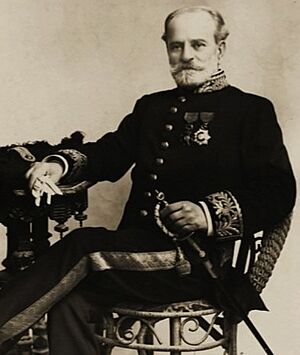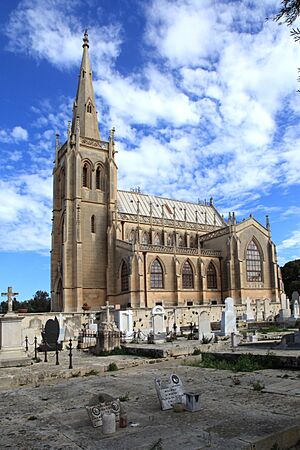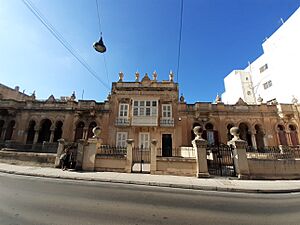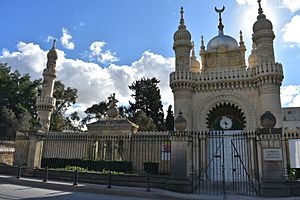Emanuele Luigi Galizia facts for kids
Emanuele Luigi Galizia (born November 7, 1830, died May 6, 1907) was a famous Maltese architect and engineer. He designed many important public buildings and churches in Malta. People often call him the most important Maltese architect of the late 1800s.
Contents
A Life in Architecture and Engineering
Galizia studied to become a civil engineer and architect at the University of Malta. In 1846, he started working for the government as an apprentice. An apprentice learns a trade by working with an experienced person.
By 1856, he became a government perito. This was a title for a skilled expert, like an architect or surveyor. Four years later, he became the chief perito. This meant he was in charge of all government public works.
In 1880, Galizia became the Superintendent of Public Works. This important job also gave him a seat on Malta's Legislative Council. This council helped make laws for Malta.
Awards and Recognition
Galizia received several important awards for his work. Pope Leo XIII made him a knight of the Order of St. Gregory the Great.
He also became a member of the Order of the Medjidie. This award was given to him by Sultan Abdülaziz of the Ottoman Empire. The Sultan visited Malta in 1867. Galizia received the award for finishing the Turkish Military Cemetery in Marsa. The Sultan himself had asked for this cemetery to be built.
Professional Development
In 1886, Galizia joined the Institution of Civil Engineers. Two years later, in 1888, he became a fellow of the Royal Institute of British Architects. These are very respected groups for engineers and architects.
That same year, the government sent him on a trip. He visited Italy, France, and England. The goal was to learn more about Gothic Revival architecture. This style brought back older Gothic designs. He also might have given advice on famous projects like the Tower Bridge in London.
Galizia also worked as an examiner at the University of Malta. He helped test students studying civil engineering.
Work in Cyprus
The British government also asked Galizia to visit Cyprus. This was soon after the British took control of the island. His task was to report on how the island could be developed. He made several visits and wrote reports. These reports were published by the government.
An obituary, a notice about someone's death, praised Galizia in 1907. It said his kindness and skill made him loved by everyone. It also noted his ability and thoroughness in his work. This gave him a lasting place in Malta's history of professional achievements.
Galizia's Unique Style
Galizia was known for a special architectural style. He used an "exotic and flamboyant arabesque style." This style included horseshoe arches and detailed carvings.
He used this style for three large houses in Sliema: Alcazar, Pax, and Alhambra. These were the first planned houses in Sliema. They stood out in the countryside. He also designed the Police Station at the Ferries landing place. Another of his designs was St. Gregory's church. The Diana fountain, which provided fresh water to Sliema, was also designed by him. Today, this fountain is in Balluta Square.
Family Life
Emanuele Luigi Galizia had children who also became notable.
His oldest son, James Galizia, followed in his father's footsteps. James became the Superintendent of Public Works. Later, he became the Treasury Secretary in Malta's government.
His second son, Godwin Galizia, was also an architect. Godwin was known for his neo-Romanesque architecture. This style used elements from old Romanesque buildings. Examples include the Church of Saint Peter in Birzebbugia and the Church of Saint Gregory in Sliema. Godwin also designed chapels and tombs for private families at the Addolorata Cemetery. His father had designed this cemetery. Godwin also designed the second Britannia Circus in Floriana. He also created two Art Nouveau villas in St. Paul's Bay. These were Villino Chapelle and Villa Preziosi.
Galizia's daughter, Giovanna Galizia, married John Caruana. He was a lawyer and a professor. Their oldest son, Anton, became a lawyer. He took the surname Caruana Galizia.
Buildings Designed by Galizia
Here is a list of important buildings that Emanuele Luigi Galizia designed or helped create:
- Ta' Braxia Cemetery, Pietà (1855)
- Addolorata Cemetery and chapel, Paola (1860)
- Prince of Wales Road (1862)
- Rinella polverista (1864)
- Armier Aqueduct between Qormi and the Three Cities (1867)
- Ta' Qali reservoir (1867)
- Some granaries at Floriana (1869)
- Second Carmelite Church, Balluta (1871)
- Turkish Military Cemetery, Marsa (1873–74)
- Bugeja Institute Technical School, Ħamrun (1880)
- Vincenzo Bugeja Institute
- Aqueduct of Sliema and Birkirkara (1882)
- Victoria Gate, Valletta (1884–85)
- Our Lady of Lourdes Church, Mġarr, Gozo (1888)
- St. Alphonse church and convent, Birkirkara (1893–95)
- Marsamxett Police Station, Valletta
- Marsa Police Station
- Sliema Police Station
- Marsaxlokk quay
- Marsamxett quay
- Villa Alhambra, Sliema (1880s) – This was Galizia's summer home. It had a Moghul and Moorish style on the outside and Baroque and Victorian inside.
- Galizia family chapel at the Addolorata Cemetery, where he is buried.
- The Church of Our Lady of Sorrows, St Paul's Bay (1902)
Galizia also oversaw the building of the Valletta Market (1859–61) and St. Vincent de Paule Hospital (1886). However, other architects designed these buildings.







